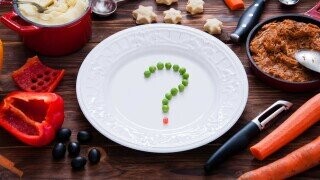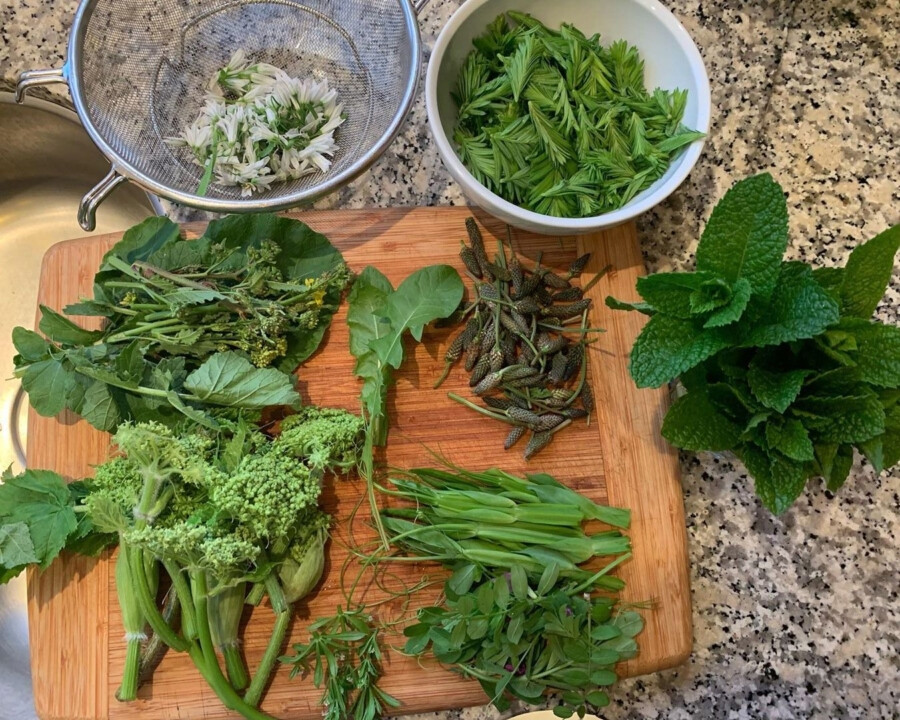Cracked's Eatin' Weird - 4 Wrong Things We Believe About Food

Having too many choices can be worse than having only a few, as evidenced by countless hours spent opening and closing freezer doors in the ice cream aisle. The same goes for nutritional knowledge, with a glut of articles, studies, op-eds, and propaganda all contending amongst each other like sports analysts arguing about Tom Brady's hair. "Does it smell like citrus? NO! Cedarwood is manlier. Cedarwood? Are you OUT OF YOUR MIND, SKIP!?"
As such, it can be tough for the average consumer to choose the correct hair care products. But this article is about food. When confronted by conflicting ice cream flavors, the sensible option is to melt them all together in a vat. But this doesn't work when parsing nutritional advice. Luckily, the following article aims to separate the chaff from the tasty bits, helping you select the most nourishing hair care products on the market today ...
GMOs Are A New, Human Phenomenon
Don't Miss
Sweet potatoes prove that even healthy things taste good when topped with marshmallows, candied pecans, brown sugar, and butter. But, fun fact, they are not tubers like regular potatoes. They're roots. But tuberous roots, which is already so complicated, it's easy to see why most folks reach for a Choco Taco instead.

Good Humor-Breyers
Sweet potatoes and Choco Tacos also prove that if GMO implies unnatural, then literally every food is unnatural because everything has been modified past resemblance to its wild form. And the genetic modification process existed long before humans ever built subterranean food labs to test which new Pop-Tarts flavors kill lab rats.
When scientists studied 291 cultivated and 9 wild sweet potato variants from disparate corners of the globe, they found something shocking. Sorry for going Daily Mail on you, but all the potatoes were GMOs. Someone had beaten Green Giant to the punch.
Was it a competing megacorp? Or secret reptile people from space? To ascertain whether reptilian space-beings were implicated, researchers checked the entire sweet potato genome for the signs of viral influences—and how wild is that, from an evolutionary vantage point? We share the universe with these not-alive but not-unalive things, viruses, some of which exist and evolve solely to terrorize sweet potatoes. Also, through basically that same process, we get border collies.
Here's the shocking surprise: no human could have altered these tuberous roots, as the genetic modification dates to 8,000 years ago. The culprit was Agrobacterium, a microbe that lives in the ground and gets frisky with a number of the vegetables that go in our mouths. It's as if this bacteria ejaculated into the global supply of sweet potatoes permanently. And with any sweet potato any of us humans eat, forever, we're consuming this ghostly bacterial jizz lineage. On the bright side, you now possess a gem of a "didja know" when grandma compliments the sweet potato casserole this Thanksgiving.
The genetic modification boded well for our ancestors. It's possible the extra DNA made the sweet potatoes meatier, more nutritious, and less like what they are: roots.

VM2002/Shutterstock
It also bodes well for all those down on their luck, love-wise. According to researchers, this is a "beautiful example of the possibility of DNA exchange across species barriers." So turn that frown upside down, friend, because if a bacterium can bang a sweet potato, then the odds of you meeting someone special aren't that crazy.
Fresh Food Is Healthiest And Leftovers Suck
Leftovers are much maligned. Not just because the sulfurous, fishy vapors emanating from a coworker's reheated salmon-cauliflower mash leave the entire real estate office smelling like a medieval brothel.

Leftovers are derided as something that was once great and is now a dim specter of its former self, like a culinary Ozymandias or the post-Macaulay Culkin Home Alones. But eating leftovers can be good for you in numerous ways.
Especially if these leftovers are starch-based. As per the rice, pasta, and potatoes that fill our fridges. And then our garbage while our flitting culinary-ADD is arrested by the wild creations issuing from the snack industry's distended anus and into our pantries and bellies.

Good Humor-Breyers
But if you're trying to lose weight, or be healthier overall, pop that Pasta Puttanesca out of the fridge and into your turd-warmer (i.e., gut). Many carb-based foods that have cooled emerge from the cold with fewer calories and more fiber because their starches transform into resistant starches that pass unchanged through the small intestine.
Cooling induces a simple physical process that changes the shape of the starches and makes them indigestible, so the body can't derive calories from them. It's akin to the block-and-hole toy that keeps your precious, precocious youngster occupied for months as he struggles to learn the true worth of a rhombus. Since enzymes can't break down the resistant starches, these neutralized carbs become prebiotics that feed the good gut bacteria implicated with all manner of health benefits.
R-starches also produce less of an insulin spike, possibly helping with diabetes and protecting against inflammatory diseases and colon cancer. Plus, the fibrosity promotes satiety, helping you eat less.

Iaroshenko Maryna/Shutterstock
Plus, a Sri Lankan study involving 38 types of rice found that cooking them with a fat (like oil), then letting them cool for 12 hours, could reduce the calorie count. Enough to offset the damage from a regretful midnight meeting with a Dale Jr. cookie sandwich.
The reductions in calories, the insulin production, the lessening of other health risks, the promise of a nicer butt, and the prebiotic effect all have important implications for the over 2 billion people who derive "up to 80% of their energy intake" from this ancient staple food crop. So what are you waiting for? Heat up that rice, or enjoy it cold, and wave goodbye to love handles, scummy gut microbes, and food waste.
Natural Is Better Than Unnatural
Bad food is made of chemicals; therefore, chemicals are bad. And bad food is bad. That makes sense, and I can't fault that logic. Especially when the entity dispensing it is wearing sprouted-mung-bean sandals and clutching a turtle-safe shopping bag made of upcycled cigarette butts from Serbian playgrounds.
But here's a life-improving pro-tip: if a person has sleeve tattoos of flowers and birds, ignore their (nutritional and health) advice. Because hey, good food has chemicals too. In fact, it might or might not be surprising to learn that all food is made of chemicals because pretty much everything is a chemical. Granted, the tumescent liquid waste from Beverly Hills fat transfers and colon irrigations is chemical in nature. But so is the delicious, nutritious sauce made from San Marzano tomatoes grown in Vesuvian soil. These substances are all chemical-based, acidic, and spew from the same orifices after overeating spaghetti.
And as some of our favorite singers, actors, and athletes have shown us, things aren't bad just because their names are long, hard to pronounce, and multitudinous. There's no better example than the following nutritional label:

It's got more "-ines" and "-ics" than a Moroccan-Polish phone book, so it's sure to give you some type of genital cancer. Or it would if it weren't a banana. Because as chemistry teacher James Kennedy says, "In reality, 'natural' products are usually more chemically complicated than anything we can create in the lab."
And that's your daily reminder that chemicals are whatever, nothing is natural, and every food you eat has been altered beyond recognition:
Sometimes these foodstuffs have been altered beyond comprehension. Take corn, for example. Its uncultivated variant, teosinte, wasn't very corny at all:

Same goes for all edible plants, which were once either small, nasty, toxic, covered in spikes, or all of the above. Yet through generations of cultivation, these fruits and veggies now supply vibrant juiciness, fat-kernelled deliciousness, and succulent sweetness, and scientists are this close to rolling out the penis-enlarging watermelon.
So the boundary between natural and artificial is, in the grand scheme of things, as existentially meaningless as the man-made divide between classes. The cosmos cares not for wealth or other forms of accumulation—its myriad crawling things and fungi feast on the flesh of industry titans as voraciously as they sup on the skin of paupers. Bon appetit!
Fancy Greens Like kale Are The Most Nutritious
Leafy greens, microgreens, macrogreens, and fractal lettuce are mainstays of the produce section at stores like Nugget or Whole Foods. Kale sales are solely responsible for at least two of Jeff Bezos' blood billions. But these overpriced veggies are no more nutritious, and sometimes less so, than the greens blooming from the gutters of San Francisco.

John O’Neill/Wikimedia Commons
UC Berkeley's Phillip Stark is a dean of sciences, a statistics professor, and a professional forager who analyzed the greenery growing in SF's underserved areas. These areas are food deserts: densely populated regions where residents must travel a mile or so to find the nearest shop that sells fresh produce. There are no Whole Foods here. Only a small Ethiopian restaurant with five tables and two Michelin stars. But why shop, when nature provides.
Stark and his Cal team collected six types of greens, including oxalis (isn't that a boner medicine?) and dandelion. Indeed, many of these specimens proved more nutritious than kale in various metrics, like vitamins, minerals, fiber, and protein. Plus, urban greens are abundant and diverse. Overall, researchers identified 52 different species here, including crack-wort, hobo's cilantro, dumpster clover, turd yarrow, fool's apricot, and various crudberries.
Yet this cornucopia is not limited to SF, and Stark finds similar fare in the equally grimy yet less historic Hayward. And other Bay Area locales. The greens here are feral species, once cultivated but then escaped into the wild, like that rat-mutant DNA which escaped the secret space station in that Rock movie I watched a third of and struggle to recall ... uuuuuh ... Mrs. Doubtfire, I believe.
Edible weeds and wild plants are everywhere. But foraging is made illegal, so California isn't picked into oblivion and turned into a gentrified Great Plains. Yet many argue that cities should stop spraying herbicides and allow foraging.
This could decrease water use and transportation and reduce waste. While allowing dietary variety, extra vitamination, and increasing insect life and biodiversity. Especially when foraging nomads squat and redeposit the seeds elsewhere, such as the PIER 39 alleyway between Footlocker and The Great Steak Experience: A Family Eatery.
Even though some of these plants may be ugly, they're nutritious and tasty. Prof. Philip Stark took a walk in the Berkeley hills and turned up a salad that could fetch three figures at trendy restaurants with chalkboards displaying multi-point philosophies about saving wild marmots:

The greens are safe to eat after a quick rinse, even if they're picked from the most beaten cityscapes or "heavily trafficked or contaminated areas."
A utopic free-eating society with no toxic chemicals would be tremendous but unrealistic given human nature. In reality, nobody walking their dog wants to fight pantless men over patches of huckleberry. Still, who knows what's possible after our reptilian overlords from Antares enact their mollifying eugenics program to create a less aggressive, more agreeable race of humans.
All that remains is for scientists to find health benefits for the other items that litter San Francisco's municipal milieu. If sun-bleached excreta, shreds of Chinese tabloids, and discarded hepatitis needles could prove humanly useful, global sustainability may be possible yet.
Top image: Letterberry/Shutterstock
